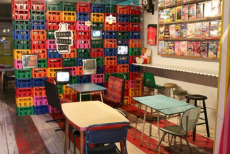
Email: stella@papersnail.co.uk
Total Article : 28
About Me:Sixth form student studying Politics, Biology and Psychology. I'm interested in a range of topics such as music, current affairs, women's issues and world politics.

Another aspect of modern life in cities such as London that has drawn upon working class culture is the ‘street food revolution’. Street markets across London that previously sold groceries to the local community (often working class) now cater to the middle-classes, wrapping up and selling the culture of their former customers. Street food sellers often serve over-priced ethnic foods to willing middle class customers who relish in the edgy, quasi-dangerous space previously occupied by the local, working community, who are often left out of the affair. An example of this is the Cereal Killer Café – a start-up in Tower Hamlets that sells children’s cereal for £4.40 a bowl. The café has come under much scrutiny due to its unfortunate location – a borough where 49% of children live under the poverty line. Many parents in the area rely on food banks to feed their children, while the first-wave gentrifiers pay £4.40 for a bowl of cereal. Of course, the Cereal Killer Café follows in the footsteps of many other gritty, urban-aesthetic bars: exposed electric wiring, milk served in reused glass milk bottles, mismatched chairs – a very edgy and cool backdrop for such gross gentrification and appropriation to occur. Street food, along with the types of bars and clubs I mentioned earlier, offer the fleeting illusion that their customers are living life on the edge, as the underdogs of society, with the romanticism that they have nothing but each other and their small London flat. This experience is artificial, and only experienced through a commodified, wrapped up and sold version of the spaces and products appropriated from below.

So what is the actual problem with working class cultural appropriation? Is it not just natural for societies classes and fashions to wax and wane as time progresses? Of course it is; fashions and past times are traded, bought, sold, copied, swapped and replaced constantly between groups. But the more I understand about cultural appropriation, the more I realise that the issue is that people want the good bits - the exciting, interesting bits of a culture, without feeling the true consequences of being a part of it. People want the streetwear, the burberry cap, Skepta, the post-squat warehouse building, the Air Max 95s - but if it’s 4 AM and they need to get somewhere, they can afford an Über, they shop at M&S, they don’t need the Job Centre and they only set foot on a council estate for a start-up’s photo shoot. That is precisely the contentious issue surrounding cultural appropriation – the aspiration of emulating a group without feeling any of the true consequences of being in it. After this fact is accepted and given its due attention, the use of working class fashions and trends could be acceptable, or even positive.
Image Credits: http://www.bqlive.co.uk/leisure-tourism-hospitality/2016/10/14/news/cereal-killer-cafe-hits-birmingham-7269/
http://www.wildaboutmagazine.com/wearing-the-working-class/

0 Comment:
Be the first one to comment on this article.